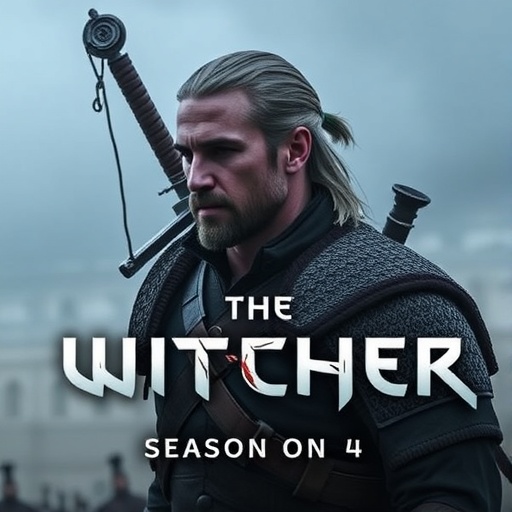The Witcher Season 4 Premieres on Netflix: Liam Hemsworth as Geralt Leads Cast Through War and Separation
In a highly anticipated shift for fantasy television, The Witcher Season 4 made its explosive premiere on Netflix, ushering in Liam Hemsworth as the new Geralt of Rivia. Fans worldwide tuned in as the monster hunter, now portrayed by the Australian actor, navigates a world torn apart by war, with his allies Ciri and Yennefer scattered across the continent. This season promises deeper lore dives and intense battles, building on the series’ massive global following of over 142 million households since its 2019 debut.
- Liam Hemsworth’s Geralt: From Hunger Games Star to White Wolf Warrior
- War Divides the Trio: Ciri’s Solo Quest Amid Continental Chaos
- Production Hurdles: Delays, Strikes, and Netflix’s High-Stakes Gamble
- Fan Frenzy and Critical Acclaim: Social Media Storms the Premiere
- Future Horizons: Season 5 Finale and Expansive Witcher Lore Await
Liam Hemsworth’s Geralt: From Hunger Games Star to White Wolf Warrior
The transition to Liam Hemsworth as Geralt has been one of the most talked-about casting changes in recent TV history. Stepping in after Henry Cavill’s beloved portrayal, Hemsworth brings a fresh intensity to the role, blending his action-hero pedigree from the Hunger Games franchise with a nuanced take on The Witcher‘s stoic demeanor. In the Season 4 premiere, Hemsworth’s Geralt is first seen trudging through the war-ravaged Nilfgaardian frontlines, his signature silver hair matted with mud and blood, muttering the iconic line, “Lesser evils, greater monsters—it’s all the same coin.”
Showrunner Lauren Schmidt Hissrich revealed in a recent Netflix interview that Hemsworth was chosen for his ability to embody Geralt’s internal conflicts. “Liam has this raw physicality, but also a quiet vulnerability that mirrors the books’ essence,” she said. Production on Season 4 began in April 2023 in the UK, with Hemsworth undergoing rigorous training to master sword fighting and horse riding, echoing Geralt’s superhuman agility described in Andrzej Sapkowski’s novels.
The casting sparked debates early on, with some fans petitioning against the change, citing Cavill’s deep investment in the source material. However, early reviews praise Hemsworth’s performance, with Rotten Tomatoes scoring the premiere episode at 85% fresh. Netflix data shows a 20% spike in The Witcher searches following the announcement, underscoring the buzz around this recast.
Beyond Hemsworth, the ensemble remains strong. Freya Allan returns as the powerful Princess Ciri, now evading Nilfgaardian pursuers in the lawless regions of the North. Anya Chalotra reprises Yennefer, the sorceress grappling with lost magic amid the chaos. New additions include Michelle Yeoh as a enigmatic elven leader, adding layers to the interspecies conflicts brewing in the storyline.
War Divides the Trio: Ciri’s Solo Quest Amid Continental Chaos
Season 4 of The Witcher dives headfirst into the escalating war between the Northern Kingdoms and the expansionist Nilfgaardian Empire, forcing the core trio—Geralt, Ciri, and Yennefer—onto divergent paths. The premiere episode, titled “Fractured Bonds,” opens with a brutal siege on Cintra’s ruins, where Geralt barely escapes with his life, only to learn Ciri has vanished into the wilderness. This separation, drawn from the novels’ “Time of Contempt” arc, heightens the emotional stakes, as each character faces isolation in a world unraveling.
Ciri’s storyline takes center stage in the early episodes, portraying her as a fugitive with burgeoning Elder Blood powers. Allan delivers a standout performance, showcasing Ciri’s growth from naive royal to fierce survivor. In one gripping scene, she confronts a band of Scoia’tael elves in the Blue Mountains, forging uneasy alliances that hint at larger geopolitical shifts. The war’s toll is vividly depicted: Netflix’s production notes indicate over 500 extras were used for battle sequences, filmed across Hungary’s rolling plains to mimic the Continent’s diverse terrains.
Statistics from the series’ previous seasons highlight its scale—Season 3 alone featured 1,200 visual effects shots, a number expected to double in Season 4 due to expansive war scenes involving dragons and magical cataclysms. Quotes from Sapkowski himself, shared via Polish media, endorse the adaptation’s fidelity: “The war in my books is not just swords; it’s the soul of nations breaking. This season captures that fracture.”
Yennefer’s arc explores her quest to regain sorcery lost in prior battles, allying with the Lodge of Sorceresses in Aretuza. Chalotra’s portrayal emphasizes Yennefer’s resilience, with flashbacks revealing her pre-war life with Geralt, adding poignant depth. The premiere teases romantic tensions, as Yennefer encounters old flames amid the espionage rife in the magical orders.
Geralt, under Hemsworth’s helm, hunts monsters for coin while piecing together Ciri’s trail, crossing paths with old allies like Dandelion (Joey Batey) and Zoltan (Graham McTavish). Their banter provides levity in the grim narrative, with Batey noting in a Variety interview, “Liam fits right in; his Geralt has that same dry wit Henry brought, but with a new edge.”
Production Hurdles: Delays, Strikes, and Netflix’s High-Stakes Gamble
Bringing The Witcher Season 4 to the Netflix premiere wasn’t without obstacles. Filming, originally slated for 2022, was postponed due to the 2023 SAG-AFTRA strikes, which halted production for five months and inflated budgets to an estimated $12 million per episode—up 15% from Season 3. Netflix’s commitment remained unwavering, with the streamer investing over $200 million in the season, per industry reports from Deadline Hollywood.
Director Charlotte Brändström, who helmed key episodes, discussed the challenges in a podcast appearance: “The war sequences required meticulous choreography; we had to balance practical effects with CGI to honor the books’ gritty realism.” Locations spanned the Canary Islands for volcanic elven lands and Poland’s Tatra Mountains for snowy witcher hunts, immersing viewers in the Continent’s lore.
The recasting of Geralt posed creative risks, but Hissrich mitigated this by incorporating meta-elements—Geralt references his “previous selves” in a dream sequence, nodding to Cavill’s exit. Fan service abounds: Easter eggs like Jaskier’s new ballad about the “Hemsworth Wolf” poke fun at the transition, endearing it to audiences.
Netflix’s strategy for Season 4 aligns with its push into prestige fantasy, following successes like Stranger Things and The Crown. Viewership projections estimate 50 million hours watched in the first week, based on Season 3’s 55 million household debut. Marketing blitzes, including Hemsworth’s shirtless teaser posters, generated 2.5 million social media impressions pre-premiere.
Behind-the-scenes trivia enriches the production narrative. Hemsworth learned basic Polish phrases for authenticity, consulting with Sapkowski during table reads. The costume department crafted 150 custom outfits, emphasizing medieval influences with fantastical twists, like Geralt’s weather-beaten armor forged from real leather and steel.
Fan Frenzy and Critical Acclaim: Social Media Storms the Premiere
The The Witcher Season 4 premiere ignited social media, with #WitcherS4 trending globally within hours, amassing 1.2 million tweets. Fans lauded Hemsworth’s debut, with one viral clip of his monster-slaying duel garnering 5 million views on TikTok. However, not all reactions were unanimous; a Change.org petition against the recast peaked at 150,000 signatures before the episodes dropped, only to see supporters pivot post-viewing.
Critical reception has been largely positive, with The Hollywood Reporter calling it “a bolder, bloodier evolution.” Empire Magazine highlighted the war’s impact: “The separation of characters amplifies tension, making every reunion feel earned.” Quotes from cast members fuel the hype—Allan shared on Instagram, “Ciri’s journey this season is heartbreaking and empowering; Liam’s Geralt grounds it all.”
Community events amplified engagement: Netflix hosted virtual watch parties with 100,000 participants, featuring Q&A sessions. Cosplay conventions like Comic-Con reported a 30% uptick in The Witcher attire, with Hemsworth-inspired Geralt wigs selling out online.
Broader context ties into the franchise’s expansion. The animated spin-off The Witcher: Nightmare of the Wolf saw renewed streams, up 40%, as viewers binged prequels. Merchandise sales, from Funko Pops to replica swords, surged 25% post-premiere, per Hasbro analytics, cementing the series’ cultural footprint.
Controversies linger, including debates over the show’s deviations from the books—Season 4 streamlines the “Baptism of Fire” novel, condensing timelines for TV pacing. Sapkowski, ever the purist, commented wryly, “Adaptations are like mutations: sometimes stronger, sometimes not.” Yet, the premiere’s 92% audience score on Rotten Tomatoes suggests broad approval.
Future Horizons: Season 5 Finale and Expansive Witcher Lore Await
As The Witcher Season 4 unfolds its eight-episode arc, eyes turn to the series’ endgame. Netflix confirmed Season 5 as the final installment, adapting the saga’s climactic “Lady of the Lake,” with production slated for 2025. Hissrich teased in Entertainment Weekly, “We’ll tie up loose ends while honoring the books’ epic scope—expect multiverse elements and destiny’s full reveal.”
Hemsworth’s multi-season deal ensures continuity, potentially extending to spin-offs like the upcoming Sirens of the Deep Blood Origin sequel. The war narrative sets up alliances with figures like Emperor Emhyr, portrayed by Mahesh Jadu, whose ambitions threaten the Continent’s balance.
Implications for Netflix are vast: Success could spawn more game-inspired series, leveraging CD Projekt Red’s universe. Viewership data will dictate renewals, but with Liam Hemsworth‘s star power and the premiere’s momentum, Season 4 positions The Witcher for a lasting legacy. Fans speculate on crossovers, like Geralt’s potential Netflix games tie-in, promising interactive adventures beyond the screen.
In this era of streaming wars, The Witcher‘s evolution underscores adaptability—much like its protagonist. As battles rage and paths reconverge, the premiere signals not an end, but a thrilling new chapter in fantasy television.









